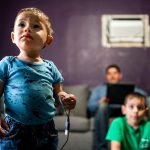A historic expansion of the child tax credit is headed to President Joe Biden’s desk after his $1.9 trillion relief package cleared Congress in a final House vote Wednesday afternoon.
The expansion of the credit, making it available to the poorest children in the country, is considered one of, if not the most, impactful elements of the package because of its potential to reduce child poverty by half, according to estimates by the Center on Poverty and Social Policy at Columbia University.
“It’s difficult to overstate. It’s easily the most significant piece of the package,” said Samuel Hammond, the director of poverty and welfare policy at the Niskanen Center, a think tank that helped craft past iterations of the child tax credit expansion. “I would put this up there with the ’35 Social Security Act in terms of its significance, but also, qualitatively, they are similar in the sense that this is Social Security for kids.”
Biden is expected to sign the bill at the White House on Friday afternoon.
How far-reaching the expansion will be rests on whether Congress can keep it in place. The relief bill expands the credit for a year, but Democrats and the president want to see it expanded permanently. They’re hoping this initial expansion makes the case for a long-term change.
Rep. Rosa DeLauro, who has at times been the lone voice advocating for the expansion of the credit, said she knows there is still a battle ahead, but she is emboldened by the president’s support. When Biden signs the package Friday, it will be 18 years to the day she first introduced the idea of making the credit fully available to the poorest children, on March 12, 2003.
“It’s a remarkable day,” DeLauro said, her voice breaking. “You think about why you serve and you think about what motivates you. … This bill is going to transform the lives of families today.”
On the House floor Wednesday, she called it “a new lifeline to the middle class.”
“Franklin Roosevelt lifted seniors out of poverty, 90 percent of them with Social Security, and with the stroke of a pen,” she said. “President Biden is going to lift millions and millions of children out of poverty in this country.”
Under the expansion, which will be in place for a year, the tax credit would rise from $2,000 to $3,000 for children ages 6 to 17. Families with children under the age of 6 will get $3,600 per child. The funds would be distributed periodically for those who qualify — either monthly or quarterly depending on what is viable for the Internal Revenue Service, which will be responsible for distributing the money. That change is a significant one: The current child tax credit is distributed annually, and the move to periodical funds will help low-wage families who need the money in the short-term.
Possibly the most important part of the law is how it changes the parameters around who can get the aid.
Families who don’t earn enough money and who don’t owe anything in taxes currently can’t get the full amount from the child tax credit. They receive up to $1,400 instead of $2,000. With the expansion in the stimulus package, those families — the nation’s poorest — will be able to get the full $3,000 or $3,600, depending on the age of their children. That means it will be “fully refundable” for 27 million children, including about half of all Black and Latinx kids. About 10 million kids will be lifted to or above the poverty line.
For example, a single mother with one young child who is a home health aide and earns $10,000 a year currently receives $1,125 through the child tax credit. Under the new plan, she would get $3,600 annually, according to estimates from the Center for Budget and Policy Priorities, a liberal think tank.
A single mother with a 4-year-old and an 8-year-old who isn’t working gets no tax credit right now. Through the expansion, she would get $6,600 annually for her two kids, the center estimated.
A married couple with a 3-year-old and a 7-year-old in which one person is earning $20,000 currently gets $2,625 — while a higher-wage family would be earning $4,000. The new bill would change that so that the low-wage family earns $6,600.
Under the changes, higher-wage families would also see a different phase out. Currently, the credit begins phasing out for single parents earning more than $200,000 or married couples earning more than $400,000. Now, the starting phase out amounts will be $75,000 for an individual, $112,500 for a single parent who are heads of households or $150,000 for couples.
Estimates have found that the expansion will help families of color most.
Poverty among Black children is estimated to decrease from 17.8 percent to 9.7 percent, according to the Center for Budget and Policy Priorities’ analysis. For Latinx children, the child poverty rate could drop from 21.7 percent to 13.4 percent. For White children, it is expected to fall from 7.9 percent to 4.6 percent.
While new to the United States, the idea of curtailing child poverty — in some cases, by as much as in half — through direct payments isn’t new around the world. In 1999, the U.K. began to do just that and a decade later, child poverty had dropped by almost half.
The U.S., meanwhile, has one of the highest child poverty rates among developed countries.
“Most developed countries have a child allowance of some sort. The U.S. is an outlier in that sense,” Hammond said. “That makes child poverty pretty low-hanging fruit, so the fact that just making the child tax credit fully refundable and increasing it is able to cut child poverty in half tells you a lot about how far away we are from diminishing returns.”
There are also broader economic implications, particularly for women. In September, about 865,000 women dropped out of the labor force — the biggest drop-off since the start of the pandemic — and much of that was driven by the start of a new school year that was largely virtual. Faced with an impossible choice, many moms chose to leave work and stay home to care for their kids. The mass closures of child care centers and schools last year directly contributed to a historic exodus of women from the workforce.
The tax credit could help with that by doling out aid to workers in essential and vulnerable positions. About 47 percent of medical assistants would benefit — 94 percent are women. Roughly 38 percent of child care workers — 95 percent of whom are women — would also see a boost. So would 36 percent of nursing, psychiatric and home health aides — about 90 percent of whom are women.
It would also put money into parents’ pockets to use on child care needs, whether through formal day care or some hodge-podge of other options that give mothers the chance to return to work.
Unlike other welfare programs that have built-in restrictions on their use, “the great thing about the child allowance is it’s entirely flexible to those child care choices,” Hammond said. “It can let you hire a nanny or babysitter or it can let you afford a day care. There’s a big sort of potential for this to invigorate bottom-up civil society.”
Putting the child tax credit in place will come with some challenges. As part of the parameters of the bill, the IRS will set up a system for distribution, as well as an online portal that also allows parents to choose if they want the checks periodically or annually and adjust any changes in their status. That’s while the agency is also managing additional unemployment insurance payments, among other coronavirus-related responsibilities that are part of the relief package.
“The IRS has never been more involved in social policy and they are being straddled with an additional priority, one that they don’t have a lot of experience,” Hammond said.
IRS Commissioner Charles Rettig said during a congressional hearing last month that the agency would need about $397 million to implement a monthly distribution of the credit.
“We not only need the funding to implement, to actually determine the requirements and to do the programming, but we also need the funding to staff and to train our staff to do it,” Retting said.
To give the IRS time to adjust, checks will start to go out in July. How successfully that rolls out may impact the shape negotiations take in a year, when Democrats will push to make the change permanent.
That has always been the goal of long-term advocates like DeLauro and is also Biden’s vision for the credit.
Politically, Democrats will have somewhat of an advantage in that conversation because the checks will be both highly visible to families receiving them regularly and are likely to be very popular. This past year, there was wide, bipartisan support for stimulus payments.
But any hiccups in the implementation of the expanded credit will open an avenue for Republicans like Sen. Mitt Romney, who have proposed different approaches to financing the credit.
Romney’s plan would distribute the money through the Social Security Administration and pay for the expansion in the long term by eliminating the state and local tax deduction, which benefits high-income households disproportionately, and other programs, including Temporary Assistance for Needy Families, which gives cash assistance to low-income families with children.
Some of those parameters will no doubt come up against opposition from Democrats, but in a split Congress, Republicans could have some influence.
“A year from now when it’s up for renewal, it’ll be really important to have at least some kind of Republican Plan B or base of support for making it permanent and, importantly, having a strategy for paying for it,” Hammond said.
DeLauro plans to return to her district in New Haven, Connecticut, this weekend and begin the work of reaching out to families who will benefit from the change. (First, though, she might celebrate with her husband.)
She’s not naive, she said — there will be more to iron out a year from now, and other plans will be in the conversation.
But, DeLauro added: “Whatever we need to do, we start today — as soon as the bill is signed. I’ll be happy to take on that fight.”






